Paintings Icons
Andrei Rublev
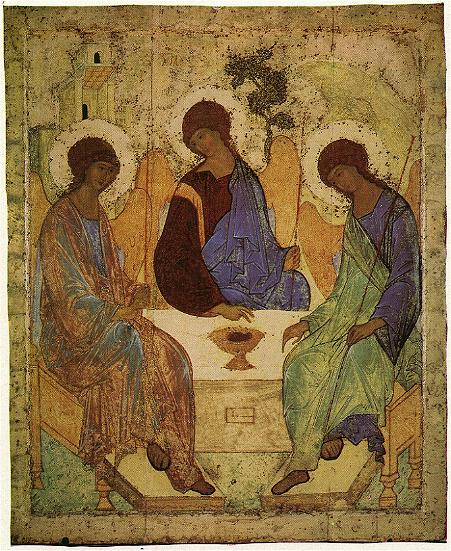 Born in a period of monastic revival, Rublev grew up in the period of increased public trust and support for the Eastern Orthodox Church. Although little is known about his life, sufficient evidence is available to begin to understand his work and the religious convictions that inspired it.
Born in a period of monastic revival, Rublev grew up in the period of increased public trust and support for the Eastern Orthodox Church. Although little is known about his life, sufficient evidence is available to begin to understand his work and the religious convictions that inspired it.
As a monk in the Trinity-St. Sergius Monastery, Rublev was doubtlessly a follower of St. Sergius (1314-1392), who was the founder of the monastery and was in many ways considered the leader of the 14th century spiritual and political revival. Life in the Trinity-St. Sergius monastery emphasized "fraternity, calm, love (toward) God and spiritual self-improvement" (Andrey Rublev). In a time of great national division and strife, St. Sergius supported the unification of the quarreling Russian principalities and freedom from the foreign oppression inflicted by the Mongol Yoke.
Many of Rublev's surviving works were created in or near Moscow, and there is evidence to suggest that he received his training in this general area (although not exactly within the city) under the guidance of Prokhor of Gorodets. By 1405 he was collaborating with Theophanes the Greek, the foremost icon painter in Russia at the time, in the decoration of the Annunciation Cathedral in Moscow. This testifies to both his skill and his rising popularity as an icon painter.
Rublev is best known for his masterpiece The Old Testament Trinity. This icon exemplifies the simplicity and the skill of his style, as well as its ability to transcend pictorial constraints with spiritual and religious ideas. Renowned for its lyrical and rhythmic quality, the icon was an instant success and found many imitators. Perhaps Rublev contributed the most to icon painting, however, when he "broke away from the prevailing severity of form, color, and expression" that characterized the developing Russian style of icon painting, especially the work of Theophanes the Greek. Thus did he infuse his work, and that of icons to come, with the gentleness and harmony characteristic for his spiritual outlook.
Dionisii
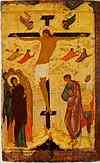 Dionisii (Dionysius) was born around 1440. He was first mentioned as a member of the team working on the paintings in the Cathedral of the Nativity in the Pafnutyev Monastery. The exclusive destiny, talent and high patrons - grand duke and the supreme spiritual persons - have provided the most favorable conditions for creativity of the master.
Dionisii (Dionysius) was born around 1440. He was first mentioned as a member of the team working on the paintings in the Cathedral of the Nativity in the Pafnutyev Monastery. The exclusive destiny, talent and high patrons - grand duke and the supreme spiritual persons - have provided the most favorable conditions for creativity of the master.
During Dionisii's life the Muscovite state succeeded in finally subjugating the independent Republic of Lord Novgorod the Great and shaking off the yoke of the Mongol control.
Continuing the traditions of Moscow icon painting, Dionisii developed a light, elegant, and sophisticated style. While traditionally the head of a represented figure fit in the body about seven times, in Dionisii's art the ratio increased to nine, sometimes even ten. His figures became elongated and buoyant through a drastic reduction of the sizes of the heads, hands, and feet. To increase the effect of ethereal elongation Dionisii used "draperies in such a way as to outline the flesh and muscles which they cover." The color palette of Dionisii also differed from the traditional palette of the Moscow artists. He introduced pastel colors, especially turquoise, pale green, and rose. By using these painterly devices, Dionisii was able to "emphasize the mystical over the dramatic content of narrative scenes."
Working on many of orders with sons and apprentices, the icon painter has created a circle of his pupils and followers. And though anybody from them did not manage to achieve that beauty and expressiveness of images, which is peculiar to paintings of the master, nevertheless works of "circle", or "school" of Dionisii differ by high art advantages.
Among the most important works attributed to Dionisii were The Crucifixion, The Metropolitan Alexis, with Scenes from His Life, The Metropolitan Peter, with Scenes from His Life, and two icons of The Virgin Hodegetria. The Crucifixion, which was painted around 1500 has a refined color palette and elegant composition. Slightly earlier Dionisii and his workshop completed the hagiographical icons of Alexis and Peter. In the first, probably painted by the master himself, we see the pastel color palette characteristic of Dionysius' later works. The delicate elongated figures almost float through the compositions of the border scenes describing events from the bishops' lives, making the images deeply spiritual and detached from reality.
Pskov School
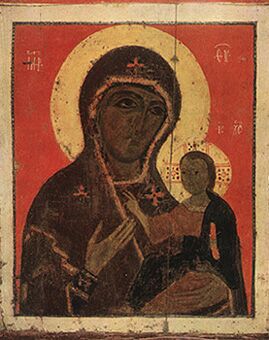
The majority of monuments of ancient painting haven't reached up till now, but northern Russian grounds are exception. They have not undergone in 13 century to such destruction, as the others. Pskov and Novgorod have kept bases of their culture, but quantity of the icons, which have reached up till now is rather limited.
The history of old Pskov was always connected with the struggle for independence. The "little brother" of Novgorod seems to have been always fighting against foreign invaders, even though, like Novgorod, Pskov was not affected by the Mongol conquest.
Pskov icons display less sophistication and artistry in execution than those of Novgorod, but they show a greater degree of poetic inspiration. Pskov icons have their own, particular style. The frescoes of Mirozhsky monastery were painted in a static and formal archaic manner. The icons of Pskov show a somber, but intense emotionalism. With time, the style of Pskov icons evolved, incorporating some elements from the Novgorodian art. From Novgorod the painters borrowed certain favorite topics and learned the use of strong outlines which increased the graphic quality of their work. The earliest Pskov icons were monumental but the painters skillfully used intense colors (different from the toned-down colors of Kievan School) and created compositions with a strong rhythmic quality, often sacrificing the elegance of proportions to the dynamism of action. The painters of Pskov had a number of favorite compositions which they liked to replicate. Like the Novgorodians, they favored St. Nicholas and Elijah, but they also found inspiration in the stories of Christ's descent into Hell, the Nativity, and the Synaxis (gathering) of the Virgin. One of the distinguishing factors of Pskovian icons is the painters' preference of the deep "Pskovian" red and the deep "Pskovian" green.
Traditions of the Pskov School of icon painting were not gone. Nowadays there are icon paiting workshops in the Pskovo-Pechorian monastery, created by Father Zinon.
The name of father Zinon has become a symbol of perfect icon painting, and a sign of revival of all orthodox art.
Simon Ushakov
 Simon Ushakov is the icon painter, artist - sculptor of monuments, author of theological compositions, thinker and teacher.
Active in Moscow, Simon Ushakov combined the traditional style of Russian icon painters with realistic details of Western European art. He became a member of the "Kremlin Armory" workshops which was a unique "academy" of the arts. There, together with his friend Iosif Vladimirov, he created a new type of art, which was more rational and less spiritual. They managed to create a more three-dimensional type of icon using chiaroscuro for modeling the faces of their subjects. Nevertheless, Ushakov also preserved the traditional technique of applying paint, from light to dark (characteristic of icon painting). He also never traded tempera for oil paint. In order to increase the sense of depth, Ushakov's landscapes and architectural motifs were borrowed from Western European art. He invited Western masters to Russia to promote and teach the different styles of painting. In 1644 he became the head of the studio which he directed until his death in 1686. At twenty-two, he was appointed a court painter. One can notice a marked duality in Ushakov. On the one hand he was an iconographer who respected and honored the traditional canons of art, on the other he was an innovator who desperately searched for new ways of artistic expression. Moreover, Ushakov was very versatile. His talent found an outlet in his work in silver shops, where he designed both jewelry and weapons. He became a famous engraver and founded his own workshop. His fame as an iconographer was established around mid-century. Most notable were his portraits of Christ, rendered in cool, pale colors. They reflect his fascination with the human face. Ushakov was an artist who helped Russian painters to make the transition to a more secular art. Some of his greatest contributions included the exterior frescoes in the Dormition Cathedral (Uspenskii Sobor) of the Moscow Kremlin. In 1664 he was officially appointed the first "iconographer of the Tsar," and worked on portraits of the Tsar (parsunas). He is also remembered for his version of Andrey Rublev's Holy Trinity and for designing a manual of icon-painting (podlinnik). Examples of his work can be found in the Tretyakov Gallery in Moscow.
Simon Ushakov is the icon painter, artist - sculptor of monuments, author of theological compositions, thinker and teacher.
Active in Moscow, Simon Ushakov combined the traditional style of Russian icon painters with realistic details of Western European art. He became a member of the "Kremlin Armory" workshops which was a unique "academy" of the arts. There, together with his friend Iosif Vladimirov, he created a new type of art, which was more rational and less spiritual. They managed to create a more three-dimensional type of icon using chiaroscuro for modeling the faces of their subjects. Nevertheless, Ushakov also preserved the traditional technique of applying paint, from light to dark (characteristic of icon painting). He also never traded tempera for oil paint. In order to increase the sense of depth, Ushakov's landscapes and architectural motifs were borrowed from Western European art. He invited Western masters to Russia to promote and teach the different styles of painting. In 1644 he became the head of the studio which he directed until his death in 1686. At twenty-two, he was appointed a court painter. One can notice a marked duality in Ushakov. On the one hand he was an iconographer who respected and honored the traditional canons of art, on the other he was an innovator who desperately searched for new ways of artistic expression. Moreover, Ushakov was very versatile. His talent found an outlet in his work in silver shops, where he designed both jewelry and weapons. He became a famous engraver and founded his own workshop. His fame as an iconographer was established around mid-century. Most notable were his portraits of Christ, rendered in cool, pale colors. They reflect his fascination with the human face. Ushakov was an artist who helped Russian painters to make the transition to a more secular art. Some of his greatest contributions included the exterior frescoes in the Dormition Cathedral (Uspenskii Sobor) of the Moscow Kremlin. In 1664 he was officially appointed the first "iconographer of the Tsar," and worked on portraits of the Tsar (parsunas). He is also remembered for his version of Andrey Rublev's Holy Trinity and for designing a manual of icon-painting (podlinnik). Examples of his work can be found in the Tretyakov Gallery in Moscow.
Moscow School
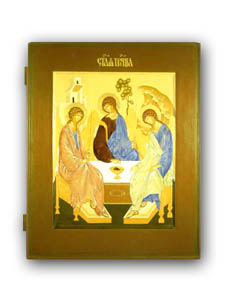
From Moscow's obscure beginnings in the twelfth century as a small village, it developed steadily to become the spiritual and political heart of Russia in the fifteenth century. During this time, the art of icon painting developed under the influence of the changing political and religious atmosphere that shaped the character of Moscow itself. Although isolated from much Western influence because of its historical ties with the Byzantine Church, Moscow became an important collector of Byzantine icons, which in turn colored the development of the Muscovite style. Because of the many fires suffered by Moscow in the fifteenth century, it is difficult to trace the development of early Muscovite icons. However, the appearance of Andrei Rublev and Dionisii (Dionysius), two important masters of Russian icon painting, shows that despite limited evidence, Moscow had been steadily developing an independent and unique painting style.While Novgorod reached its peak in icon painting between the fourteenth and sixteenth centuries, Moscow's development continued and reached its greatest achievements in the sixteenth century. The different social, geographical, and political position of each region in turn influenced the development and spirit of its icons. While there are similarities in their styles, the Moscow style, reaching its peak after the political subjugation of the unruly republic of Lord Novgorod the Great, took these similarities to another level.
Since Moscow's art had traditional ties with that of the Byzantine Church, new developments in Muscovite style can be traced by contrasting them with their Byzantine heritage. One important development was the change from the severe, harsh portrayal of the Pantokrator as found in the Byzantine models, to the more gentle, compassionate-looking Pantokrator, perfectly rendered by Andrei Rublev. Not only did his image of the Pantokrator differ from Byzantine images, but it also contrasted with the "traditional linearism" found in Novgorodian representations of Christ. This move towards a gentler and softer style of painting, which puts more emphasis on blending of warm colors than on sharp outlines, is characteristic of the Moscow school in particular, and the art of Russia in general.
Important developments in the Moscow school can be seen through the works of four masters of icon painting: Theophanes the Greek, Andrei Rublev, Dionisii (Dionysius), and Simon Ushakov. Theophanes the Greek (ca. 1330-ca. 1410) was known for his quick and skillful representation of figures, as well as for his characteristic use of monochromatic colors (in frescoes) and bright highlights to create depth and contour. Andrei Rublev (c.1370-1430) was probably influenced by Theophanes, but developed his own unique style that was, and still is, highly valued for its sense of unity and spiritual depth. His most famous work, The Old Testament Trinity, served as a prototype, highly praised and endorsed by the Russian Orthodox Church as an example for future representations of the Godhead. Although Dionisii' fame was widespread in the writings of his time, little of his prolific output remains today (most popular are the icons of The Crucifixion and The Virgin Hodegetria, two hagiographical icons of the Metropolitan Alexis and the Metropolitan Peter, and the frescoes in St. Therapont Monastery). His style was a continuation of the "intense spirituality and delicate coloristic grace" (Hamilton) characteristic of the Moscow school after Rublev . Finally, Simon Ushakov (1626-1686), the head of the "tsar's icon painters," brought the icon painting to its ultimate baroque apogee and, from the Orthodox point of view, demise. His Western-influenced faces of Christ and the Virgin, while truly beautiful, take the icon painting out of the spiritual realm into the real world. These four icon painters profoundly affected the art of their times and the development of the Moscow school of icon painting.
The Moscow school of icon painting can be characterized by several common features:
- increased complexity in compositions and theological symbolism
- more tender representations of Christ and the saints
- considerable elongation of figures
- warm, saturated colors and more variation in their selection, including the introduction of pastels
- increasing degree of miniaturization, leading in the 16th century to Stroganov School, in the 17th to the art of the tsar's icon-painters (partially influenced by Western art), and in the 18th century to local icon-painting workshops (Palekh, Mstera)
- "realistic" tendency
Kiev School
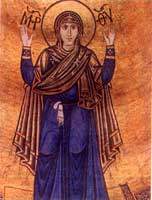 The icon has appeared in Ukraine approximately in 988.
The icon has appeared in Ukraine approximately in 988.
The earliest Russian icons, no matter in what city they were created, should be attributed to the Kiev School. This school was active from the end of the 10th century, the time of Christianization of Russia, until Kiev was sacked and burned by the Mongols in 1240. And even though there might have been some icon painting in Kiev after the fall of the capital, the center of icon painting moved to the north, to Novgorod.
The first icons were brought to Russia from the Byzantine Empire and from Bulgaria, which became an intermediary between Constantinople and Kiev, supplying the newly Christianized state with books, icons, and liturgical objects necessary for the celebration of the mass. We may suspect that the first painters in Kiev were also Greeks or Byzantinized South Slavs. They became teachers of the first Russian painters and gave them a sound training in the Byzantine style and tradition. Since Russians were always exceedingly adept not only at blind mimicking but at taking a step forward, they quickly learned how to extend the Byzantine style and tradition and make it their own. The early Russian (Kiev) style was still quite dependent on the Byzantine. The compositions were monumental, uncluttered, and simple. Some icons exhibited close affinities with the art of classical antiquity. Most Kievan School icons were painted in darker, more somber tones and were often large in dimensions because they were hand hewn with an axe from a large piece of wood. However, the Russians very quickly abandoned the Byzantine tradition of portraying Christ Pantokrator as a severe and strict judge and started developing a more "humane," understanding, and forgiving image of Christ, the Savior and the Redeemer. This tendency led later, in the Novgorodian and Moscow traditions to the development of a Savior type best known from the work of Andrei Rublev, and to the appearance of the "Russian" variants of many saints, particularly St. Nicholas and St. George.
The founder of the Kiev school is metropolitan Illariona, who has acted against dominance of the Byzantian Greeks in sphere of icon painting in territory of the Kiev Russia. Icon workshops were at temples of Saint Sofia and in Pechyorsky monastery, founded by Antony and Teodosy. Classical icon painting developed in Ukraine according to orthodox canons (but basically lime boards were used), icons were painted also on glass (basically in the Western Ukraine) and were embroidered on fabric. Mass demand for icons has caused to life unique phenomenon "people icon painting", i.e. many self-educated persons wrote icons on order and even painted rural churches and temples, bringing their own vision of saint images. During Soviet times many of temples were destructed. Because of mass burning of icons many natives from Ukraine worked basically abroad, painting there temples and creating icons. Now restoration of temples and revival of religious freedom of Ukraine citizens create the certain preconditions for new revival of Ukrainian icon painting.
Theophanes the Greek
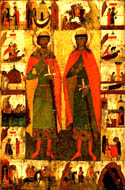
Theophanes the Greek is believed to have been born in the 1330's and to have died sometime between 1405 and 1409. He had been well read in religious literature and art before his arrival in Novgorod around 1378. During his self-contained, quiet, short-lived stay in Novgorod, Theophanes painted famous murals in the church of Transfiguration on the Ilyin Street. His works are also present in the Church-on-Volotovo-Field and in the Cathedral of St. Theodore Stratilates. After working in Kostroma in 1390, Theophanes moved to Moscow in 1395 as it was entering a new stage of history attempting to lead Russia to unification of divided lands and to the end of the Mongol yoke. Theophanes' first Muscovite work was the Book of Gospels of Boyar Koshka, for which he painted miniatures and which would later be used as the basis of the Khitrovo Gospels. Although Theophanes must have painted many icons throughout his life, scholars believe that the following nine are indisputably his: The Dormition of the Virgin, The Virgin of the Don (both 1392) and The Saviour in Glory, The Virgin, St. John Chrysostom, Archangel Gabriel, St. Paul, St. Basil, and St. John the Evangelist, all of which were painted in 1405 for the Deesis tier in Moscow's Cathedral of the Annunciation.
The fame of Theophanes in Moscow was so great that Epiphanios the Wise, a famous 14th-15th-century writer who knew the painter well, felt compelled to describe in a letter to his friend the master's method of work, apparently quite extraordinary at the time: "When he was drawing or painting . . ., nobody saw him looking at existing examples, as would do some of our icon painters, who would constantly stare at them with amazement, looking here and there, doing less of actual painting than looking at examples. He, on the contrary, appeared to paint his frescoes with his hands while walking back and forth, talking to the visitors, considering inwardly what was lofty and wise and seeing the inner goodness with the eyes of his inner feelings."
Novgorod School
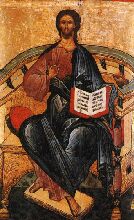
Novgorod has always been a very important Russian city and one of the most ancient centres of culture.
Once a prosperous mercantile community, it kept its independence until 1478, when it succumbed to Moscow. Before then it distinguished itself for its economic, social, political and artistic achievements. As early as the10th century, it became the cradle for new political ideas. Novgorod was a republic (it called itself Lord Novgorod the Great), governed by the veche, a democratic assembly of all citizens, roughly resembling a parliament. The citizens were called to special meetings by the veche bell; the participants made their decisions together. The Novgorodians rejected the idea of the princely rule; instead, they hired a prince when they needed a leader to help them fight their enemies. When the danger was over, the prince was dismissed and asked to leave the city. The princes' names had been often linked with the building of the most famous churches and cathedrals: Cathedral of St. Sophia (1045- 1050), the Nikolo-Dvorishchensky Cathedral (1113) and the Cathedral of Saint George in the Yuriev Monastery (1119).
Not many Novgorodian 11th-century paintings have survived, but the surviving works of the 12th century (sometimes only fragments) help prove the existence of an independent local painting tradition. The frescoes at Nereditsa and in the Church of St. George at Staraia Ladoga are the evidence of this kind. Icons from the same period display a very strong Greek influence even though they show a very characteristic Russian style at the same time. In the 13th, 14th and 15th centuries, Novgorod produced some of the greatest works of medieval Russian art, best represented by the paintings of Theophanes the Greek (Feofan Grek). In some of his greatest works it is possible to find the combination of the local style with the style of Constantinople, where he worked before coming to Russia. Most notable are his frescoes in the Church of the Transfiguration on Ilyin Street (1378), the icon of the Virgin of the Don, The Dormition of the Virgin, and The Transfiguration. Later, Theophanes moved to Moscow and contributed to the development of the Moscow School, particularly by working together with Andrei Rublev and other Moscow masters.
Icons represent Novgorodian art better than any other artistic genre . Their style, which developed through the centuries, was probably based not only on "imported" Byzantine examples but on the existing tradition of popular folk art. Early icons are conventional but reflect the spiritual strength and beauty of man. They are simple, laconic and precise; the compositions are based on contrast between large shapes, the colors are saturated and bright, and the drawing is energetic. In the 12th and 13th centuries an emphasis is put on contrasting colors and simplicity of the image. Among the saints most beloved and popular in Novgorod are Saint Nicholas, St. George, Elijah, Paraskeva Piatnitsa (Friday), Florus and Laurus, and Cosmas and Damianos. Most of these saints were particularly venerated because their celebrations fell on the days important for the peasant's agricultural calendar or because they were connected to the ancient Slavic pagan gods (Saint Nicholas to Veles, St. George to Dazhbog, Elijah to Perun, Paraskeva to Mokosh, and Cosmas and Damianos to Svarog).
Some of the most important features of the mature Novgorodian style of icon painting include:
- brightness of colors;
- increased complexity as compared to Kievan and earlier
Novgorodian icons;
- increased liveliness characteristic of their developing "anecdotal style" (Hamilton, 153);
- "graphic" quality (emphasis on drawing and line).
The late 13th and early 14th century feature a change in style and the introduction of more monumental, flat, graphic qualities together with relative depth of form. The dominant colors are cinnabar, white, ochre, brown and green. The 14th century, a period of great prosperity for Novgorod, is reflected in a proliferation of Novgorodian icons. The period that follows marks another stylistic change: the 15th-century palette becomes remarkably lighter and the compositions are more dynamic and mobile. Moreover, a precise canonical system for the arrangement of icons in the iconostasis wall is finally established. At the end of the 15th century Novgorodian art begins to decline as a result of Moscow's political dominance and the influence of the art of such great Moscow painters as Daniil Chornyi (Daniel the Black), Prokhor of Gorodets, Andrei Rublev, and Dionisii(Dionysius). In Great Novgorod the outstanding monuments of medieval architecture and painting are concentrated . Among them the most ancient in Russia temple - Sofia cathedral, based in the middle of XI century and Yuriyev monastery, based in beginning of XII century. Many monuments of architecture have kept fresco painting (unfortunately, fragmentary).
|